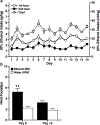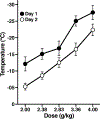Tolerance to alcohol: A critical yet understudied factor in alcohol addiction
- PMID: 33631255
- PMCID: PMC8917511
- DOI: 10.1016/j.pbb.2021.173155
Tolerance to alcohol: A critical yet understudied factor in alcohol addiction
Abstract
Alcohol tolerance refers to a lower effect of alcohol with repeated exposure. Although alcohol tolerance has been historically included in diagnostic manuals as one of the key criteria for a diagnosis of alcohol use disorder (AUD), understanding its neurobiological mechanisms has been neglected in preclinical studies. In this mini-review, we provide a theoretical framework for alcohol tolerance. We then briefly describe chronic tolerance, followed by a longer discussion of behavioral and neurobiological aspects that underlie rapid tolerance in rodent models. Glutamate/nitric oxide, γ-aminobutyric acid, opioids, serotonin, dopamine, adenosine, cannabinoids, norepinephrine, vasopressin, neuropeptide Y, neurosteroids, and protein kinase C all modulate rapid tolerance. Most studies have evaluated the ability of pharmacological manipulations to block the development of rapid tolerance, but only a few studies have assessed their ability to reverse already established tolerance. Notably, only a few studies analyzed sex differences. Neglected areas of study include the incorporation of a key element of tolerance that involves opponent process-like neuroadaptations. Compared with alcohol drinking models, models of rapid tolerance are relatively shorter in duration and are temporally defined, which make them suitable for combining with a wide range of classic and modern research tools, such as pharmacology, optogenetics, calcium imaging, in vivo electrophysiology, and DREADDs, for in-depth studies of tolerance. We conclude that studies of the neurobiology of alcohol tolerance should be revisited with modern conceptualizations of addiction and modern neurobiological tools. This may contribute to our understanding of AUD and uncover potential targets that can attenuate hazardous alcohol drinking.
Keywords: Alcohol dependence; Alcohol use disorder; Alcoholism; Drug addiction; Ethanol; Preclinical models; Rodent models.
Copyright © 2021 Elsevier Inc. All rights reserved.
Figures



Similar articles
-
Neurobiological signatures of alcohol dependence revealed by protein profiling.PLoS One. 2013 Dec 16;8(12):e82656. doi: 10.1371/journal.pone.0082656. eCollection 2013. PLoS One. 2013. PMID: 24358215 Free PMC article.
-
NEUROBIOLOGICAL BASES OF ALCOHOL ADDICTION.Acta Clin Croat. 2016 Mar;55(1):134-50. doi: 10.20471/acc.2016.55.01.19. Acta Clin Croat. 2016. PMID: 27333729 Review.
-
Neuropharmacology of alcohol addiction.Br J Pharmacol. 2008 May;154(2):299-315. doi: 10.1038/bjp.2008.30. Epub 2008 Mar 3. Br J Pharmacol. 2008. PMID: 18311194 Free PMC article. Review.
-
Biochemical basis of alcoholism: statements and hypotheses of present research.Alcohol. 1985 Nov-Dec;2(6):711-88. doi: 10.1016/0741-8329(85)90093-x. Alcohol. 1985. PMID: 3006723 Review.
-
Neurobiological correlates of the disposition and maintenance of alcoholism.Pharmacopsychiatry. 2003 Nov;36 Suppl 3:S255-8. doi: 10.1055/s-2003-45139. Pharmacopsychiatry. 2003. PMID: 14677088 Review.
Cited by
-
Multiple diverse drinking trajectories among sexual minority women: Unique and joint prediction by minority stress and social influence risk factors.Addict Behav. 2022 Jun;129:107273. doi: 10.1016/j.addbeh.2022.107273. Epub 2022 Feb 3. Addict Behav. 2022. PMID: 35219035 Free PMC article.
-
Does tolerance to ethanol-induced ataxia explain the sensitized response to ethanol?Front Psychiatry. 2024 Aug 30;15:1418490. doi: 10.3389/fpsyt.2024.1418490. eCollection 2024. Front Psychiatry. 2024. PMID: 39279806 Free PMC article.
-
Synaptic Mechanisms of Ethanol Tolerance and Neuroplasticity: Insights from Invertebrate Models.Int J Mol Sci. 2024 Jun 21;25(13):6838. doi: 10.3390/ijms25136838. Int J Mol Sci. 2024. PMID: 38999947 Free PMC article. Review.
-
Acute Administration of Ethanol and of a D1-Receptor Antagonist Affects the Behavior and Neurochemistry of Adult Zebrafish.Biomedicines. 2022 Nov 10;10(11):2878. doi: 10.3390/biomedicines10112878. Biomedicines. 2022. PMID: 36359397 Free PMC article.
-
Subregional Differences in Alcohol Modulation of Central Amygdala Neurocircuitry.Front Mol Neurosci. 2022 Jul 5;15:888345. doi: 10.3389/fnmol.2022.888345. eCollection 2022. Front Mol Neurosci. 2022. PMID: 35866156 Free PMC article. Review.
References
-
- American Psychiatric Association, 2013. Diagnostic and Statistical Manual of Mental Disorders, 5th edition. American Psychiatric Publishing, Washington, DC.
-
- American Psychiatric Association, 1980. Diagnostic and Statistical Manual of Mental Disorders, 3rd edition. American Psychiatric Press, Washington DC.
-
- Aoun EG, Jimenez VA, Vendruscolo LF, Walter N. a. R., Barbier E, Ferrulli A, Haass-Koffler CL, Darakjian P, Lee MR, Addolorato G, Heilig M, Hitzemann R, Koob GF, Grant KA, Leggio L, 2017. A relationship between the aldosterone-mineralocorticoid receptor pathway and alcohol drinking: preliminary translational findings across rats, monkeys and humans. Mol. Psychiatry. 10.1038/mp.2017.97 - DOI - PMC - PubMed
Publication types
MeSH terms
Substances
Grants and funding
LinkOut - more resources
Full Text Sources
Other Literature Sources
Medical

